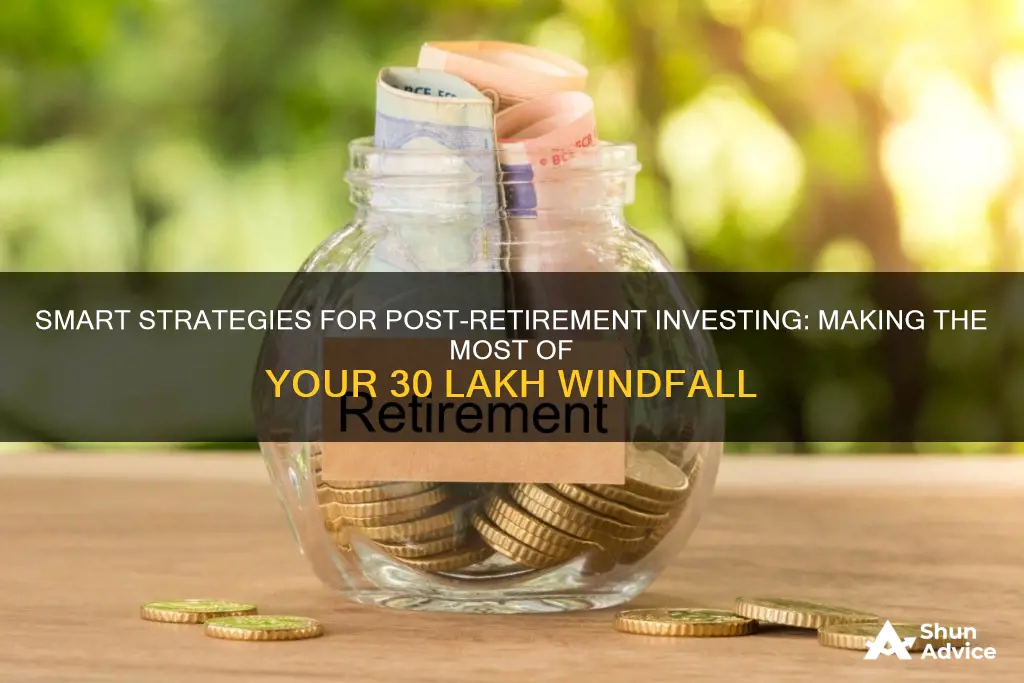
Investing 30 lakhs after retirement can be a challenging task, but with careful planning, it can be done successfully. The key is to create a robust investment strategy that ensures a regular income stream while also offering potential tax savings and capital protection. For senior citizens in India, a combination of different investment options such as the Senior Citizen Saving Scheme (SCSS), Pradhan Mantri Vaya Vandana Yojana (PMVVY), Post Office Monthly Income Scheme (POMIS), Fixed Deposits (FDs), and carefully selected mutual funds can be considered. It is important to calculate the actual monthly need, taking into account any other sources of income, and to not ignore the impact of inflation when planning for the future.
| Characteristics | Values |
|---|---|
| Investment type | Senior Citizen Saving Scheme (SCSS), Pradhan Mantri Vaya Vandana Yojana (PMVVY), Post Office Monthly Income Scheme (POMIS), Fixed Deposits (FDs), Mutual funds, Equity |
| Investment amount | Rs. 30 Lakh |
| Income generation | Regular income |
| Risk level | Low to medium |
| Returns | 6%-10% |
| Inflation protection | Yes |
| Liquidity | High |
| Tax implications | Interest income is taxable |
| Emergency fund | Yes |
| Investment horizon | 3 years or more |
| Investment vehicles | Debt funds, Tax-free bonds, Equity funds, Short-term income plans, Liquid funds, Ultra short-duration funds |
What You'll Learn

Senior Citizen Saving Scheme (SCSS)
The Senior Citizen Savings Scheme (SCSS) is a government-backed savings option designed to provide financial security to senior citizens. The scheme is open to individuals aged 60 and above, or 55 for retired defence personnel and those taking voluntary retirement. It offers a competitive interest rate of 8.2% per annum (as of Q1 FY 2024-25), with the option of extending the maturity period for an additional 3 years after the initial 5-year term. The minimum investment amount is Rs. 1,000, while the maximum is Rs. 30 lakh.
The SCSS provides a regular flow of income with quarterly interest payouts. It also offers tax benefits, with deposits qualifying for tax deductions under Section 80C of the Income Tax Act, up to a limit of Rs. 1.5 lakh per year. The scheme is backed by the government, ensuring a high level of safety and security for investments.
To open an SCSS account, individuals can visit a designated post office or authorised bank in India. The process is relatively simple and can be completed by filling out an application form and providing the necessary documents, such as proof of identity and address.
The SCSS is a popular option for senior citizens in India due to its combination of high interest rates, tax benefits, and the flexibility of multiple account options. It provides a safe and secure investment opportunity, making it a favourable choice for retirees seeking regular income and capital protection.
Investment Strategies: Navigating the Ideal Percentage of Your Paycheck to Invest
You may want to see also

Pradhan Mantri Vaya Vandana Yojana (PMVVY)
PMVVY gives a guaranteed pension payout at a specified rate for 10 years. The scheme provides an assured return of 7.4% per annum, which can be paid out monthly, quarterly, half-yearly, or annually, depending on the individual's preference. The pension amount is calculated based on the purchase price, which is a lump sum amount invested to secure a fixed income for 10 years. For example, an investment of Rs. 8 Lakh would result in a pension amount of Rs. 6,000 per month for 10 years or until the pensioner survives within this 10-year tenure.
The scheme also offers a maturity benefit, where the lump sum purchase price of the plan is paid along with the last instalment at the end of the 10-year policy term. In the event of the pensioner's death during the policy term, their beneficiary will receive the entire purchase amount as a claim. Additionally, the scheme allows for premature exit, with 98% of the purchase value returned during early withdrawal. After completing 3 successful policy years, individuals can also avail of a loan against their PMVVY investment, borrowing up to 75% of the purchase amount.
PMVVY provides financial security and peace of mind for senior citizens, ensuring a steady income stream during their retirement years.
Two Harbors Investment Corp: Dividend Payment Date and Expectations
You may want to see also

Post Office Monthly Income Scheme (POMIS)
The Post Office Monthly Income Scheme (POMIS) is a Government of India-backed small savings scheme that allows investors to deposit a specific amount every month. Interest is then added to this investment at the applicable rate and paid out to the depositor(s) on a monthly basis.
POMIS is suitable for investors seeking a one-time investment to serve the purpose of getting regular income to maintain their lifestyle, as well as investors willing to make long-term investments. It is a secure and popular investment option in India, offering a guaranteed monthly income to investors, and is, therefore, a preferred choice for individuals seeking regular income.
Eligibility
The MIS Post Office Scheme is open to all Indian citizens, excluding NRIs. A minor account can be opened for children above 10 years, with withdrawals permitted after maturation at 18 years.
Investment Amount
Any amount in multiples of Rs. 100 is accepted under the MIS scheme. The minimum investment amount is Rs. 1,500, while the maximum investment amount is Rs. 9 Lakhs for an individual account and Rs. 15 Lakhs for a joint account (up to 3 joint holders).
Lock-in Period
The invested amount is locked in for a minimum of 5 years under the monthly income scheme.
Transferability
You can transfer your Post Office Monthly Income Scheme account to a more convenient post office if you relocate within India.
Tax Benefits
While the interest is not subject to TDS, it doesn't qualify for tax benefits under Section 80C. The interest income from POMIS is added to the total income and taxed according to the applicable slab rates.
Boeing: Invest or Avoid?
You may want to see also

Fixed Deposits (FDs)
When investing in FDs, individuals need to consider the interest rates, reputation of the financial institution, and other factors. It is also important to remember that early withdrawal from FDs is possible but may result in financial repercussions and penalties.
Interest Rates and Returns
FDs offer higher returns compared to regular savings accounts. The interest rates vary across financial institutions and are typically higher in private sector banks and NBFCs. Senior citizens can expect higher returns, with rates approximately 0.25-0.5% higher than those offered to standard depositors. The interest earned on FDs is taxable, and individuals should consider the tax implications when making investment decisions.
Flexibility and Tenure
FDs offer flexibility in terms of tenure, with options ranging from very short-term (7-14 days) to long-term (up to 10 years) investments. Individuals can choose the tenure that best suits their financial goals and investment horizon. Additionally, FDs provide flexibility in terms of interest payout frequency, with options for monthly, quarterly, annual, or cumulative interest payouts.
Safety and Stability
FDs are considered a safe and stable investment option. They provide guaranteed returns, ensuring stability and peace of mind for retirees. The principal amount invested in FDs remains intact, and individuals can expect to receive their invested sum back at the end of the tenure.
Eligibility and Requirements
To open an FD account, individuals need to meet the eligibility criteria and submit necessary documents for identity and address proof. Senior citizens and minor investors are also required to provide age proof documents. FDs can be opened through online or offline modes, depending on the financial institution.
Advantages of FDs for Retirees
FDs are well-suited for retired individuals as they offer a stable and predictable source of income. The guaranteed returns and low risk make FDs an attractive option for those seeking to ensure a comfortable retirement. Additionally, the higher interest rates offered to senior citizens can boost their post-retirement financial security.
In conclusion, Fixed Deposits (FDs) can be a valuable component of a retirement investment strategy. They offer stability, flexibility, and guaranteed returns, making them a popular choice for individuals looking to secure their financial future after retirement. However, it is important to carefully consider the interest rates, tenure, and potential financial repercussions of early withdrawal before investing in FDs.
Coca-Cola: A Refreshing Investment
You may want to see also

Mutual funds
Senior Citizen Saving Scheme (SCSS)
The Senior Citizen Saving Scheme is a government-backed scheme that offers a fixed income with guaranteed returns for senior citizens. The current interest rate is 8.2%, and the maximum investment allowed is 15 lakhs. The interest is payable quarterly, and the scheme has a lock-in period of 5 years, with the option to extend it for another 3 years. The interest income is taxable, but investments up to 1.5 lakhs in SCSS qualify for a tax deduction.
Post Office Monthly Income Scheme (POMIS)
The Post Office Monthly Income Scheme provides a monthly income suitable for senior citizens looking for a fixed income without exposure to market risks. The interest rate is currently 7.4%, and the maximum investment limit for a single account is 4.5 lakhs. The interest income is added to the total income and taxed according to the applicable slab rates.
Fixed Deposits (FDs)
Many banks in India offer special FD rates for senior citizens, typically 0.5% to 0.75% higher than regular rates. FDs provide a predictable income stream with no market risk, making them an attractive option for retirees. The interest income from FDs is taxable, but there is a deduction of up to 50,000 rupees available under Section 80TTB on interest income from deposits.
Debt Mutual Funds
Debt mutual funds are suitable for retirees looking for moderate risk and stable returns. They invest in fixed-income instruments such as government securities, corporate bonds, and money market instruments. Debt funds are typically less volatile than equity funds and provide regular income through dividends or interest payments. However, it is important to consider the credit risk and interest rate risk associated with debt funds.
Equity Mutual Funds
Equity mutual funds invest primarily in stocks and are suitable for retirees with a long-term investment horizon and a higher risk appetite. They offer the potential for higher returns but come with higher risk. It is recommended to allocate only a small portion of the capital to equity funds, as they can be volatile. When selecting equity funds, consider factors such as performance track record, fund management, expense ratios, and alignment with your risk profile.
When investing in mutual funds, it is essential to assess your risk tolerance, investment goals, and time horizon. Consult with a financial advisor to tailor a mutual fund portfolio that suits your specific needs and circumstances.
Art That Pays: Unveiling the Secrets to Smart Investing
You may want to see also
Frequently asked questions
Investing in a combination of financial instruments such as the Senior Citizen Saving Scheme (SCSS), Post Office Monthly Income Scheme (POMIS), and Fixed Deposits (FDs) can provide a regular income stream. The SCSS offers a higher interest rate of around 8% and is considered one of the safest options.
Investing 30 lakhs in SCSS can provide a quarterly interest income of around 60,000 rupees, which equates to approximately 20,000 rupees per month. This interest income is taxable.
Yes, the Pradhan Mantri Vaya Vandana Yojana (PMVVY) is a pension scheme that offers guaranteed returns for senior citizens. It provides a fixed income for ten years, with the option of monthly, quarterly, half-yearly, or yearly payouts.
Besides SCSS and PMVVY, you can consider investing in debt funds, mutual funds, annuities, or immediate annuity plans. Debt funds are expected to earn more than 10% over the next five years, providing a good option for those seeking safe and better growth.
You can manage the TDS part by furnishing Form 15H. Additionally, investments up to 1.5 lakhs in SCSS qualify for a tax deduction under Section 80C. Consult a financial advisor to understand the tax implications of your specific investment choices.







